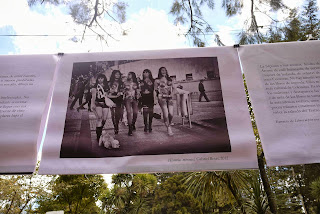
United States photographer Alec Soth was evidently enchanted by Bogotá while he lived here during the adoption process of his daughter a few years ago. And he recorded his impressions, many of them of dogs, and now has them on display in the Museo de Bogotá in La Candelaria.
 I'm no judge of photography, but that has never stopped me from expressing opinions. I'm not exactly sure what gives these photos more artistic value than photos of dogs which most people could take. For a Bogotá resident, who sees these same sorts of dogs and bogotanos every day, the photos seem routine. But they might be interesting for someone who's never visited here, particularly if the only images of Colombia they've seen involve drugs, bombings and kidnappings.
I'm no judge of photography, but that has never stopped me from expressing opinions. I'm not exactly sure what gives these photos more artistic value than photos of dogs which most people could take. For a Bogotá resident, who sees these same sorts of dogs and bogotanos every day, the photos seem routine. But they might be interesting for someone who's never visited here, particularly if the only images of Colombia they've seen involve drugs, bombings and kidnappings.But art is all subjective, and Colombian adoption is more interesting to talk about.
 |
| This happens to be the street I live on in La Candelaria. The Santa painting has since disappeared. |
 But in recent years, following scandals, Colombia has made the adoption process longer and more demanding and given priority to Colombian families over foreign ones. In mid-2012, Colombia put a hold on new applications from foreigners for children under six years old who don't have either physical or mental problems.
But in recent years, following scandals, Colombia has made the adoption process longer and more demanding and given priority to Colombian families over foreign ones. In mid-2012, Colombia put a hold on new applications from foreigners for children under six years old who don't have either physical or mental problems.Despite these new restrictions, as well as long waiting times, Colombia seems to be receiving lots of attention from adoption agencies because many other countries have restricted foreign adoptions even more.
Adoption can be a wonderful thing, and the adoptees from Colombia I've met have seemed generally healthy, happy and satisfied with their lives (altho those who were not probably wouldn't have come to visit in the first place). But adoption can go wrong, and adoptees are sometimes exploited. Read this jarring Reuters investigation about how U.S. families 're-home' adopted children they don't like using online networks.
 And, disturbingly, I found at least one adoption site with this glib pitch which focuses on the adoptive families' convenience, not so differently from selling any sort of inanmate product.
And, disturbingly, I found at least one adoption site with this glib pitch which focuses on the adoptive families' convenience, not so differently from selling any sort of inanmate product.Medical and psychological evaluations are provided with all referrals, providing a complete overview of the child a family is adopting. These wonderful children are often home in as little as six months. For families who want to provide a home to an older child, Colombia is a perfect adoption option....
Why Adopt From Colombia
Healthy, well-adjusted older children and sibling groups available
Sibling groups are available of all ages
One of the most affordable adoption programs available anywhere
Short waiting time

Previous divorce acceptable
It makes me wonder whether, pitching children this way, however positive the intentions may be, only sets families up for disappointment and rejection when parenting turns difficult.
The best-known adoption of Colombia children in recent times was that of two young boys by a New York Times reporter who is gay. Predictably, conservatives tried to block the adoption. I haven't seen anything since about how the boys are doing. According to adoption websites, Colombia now frowns on gay couples and single men adopting from here.
By Mike Ceaser, of Bogotá Bike Tours




























































